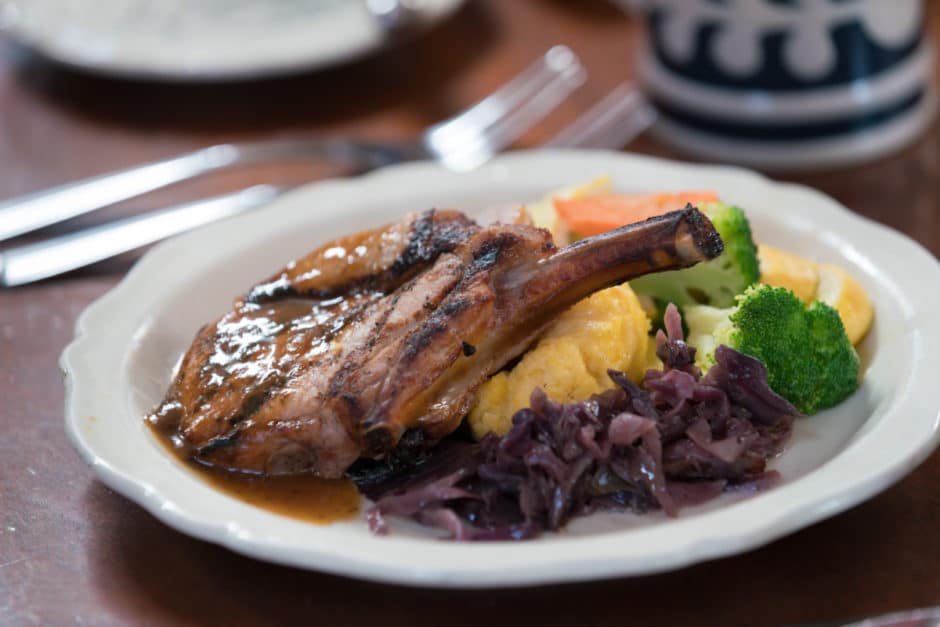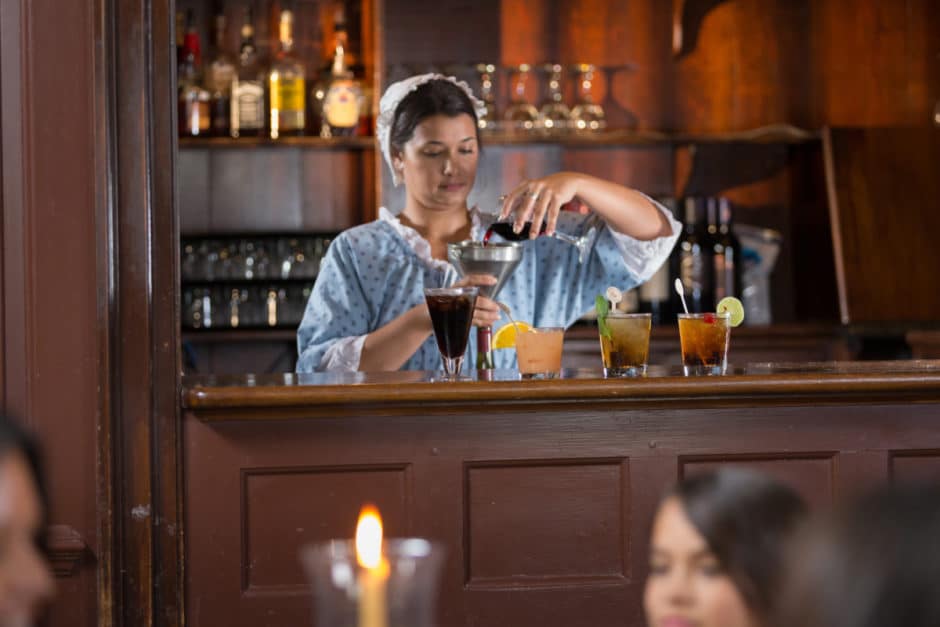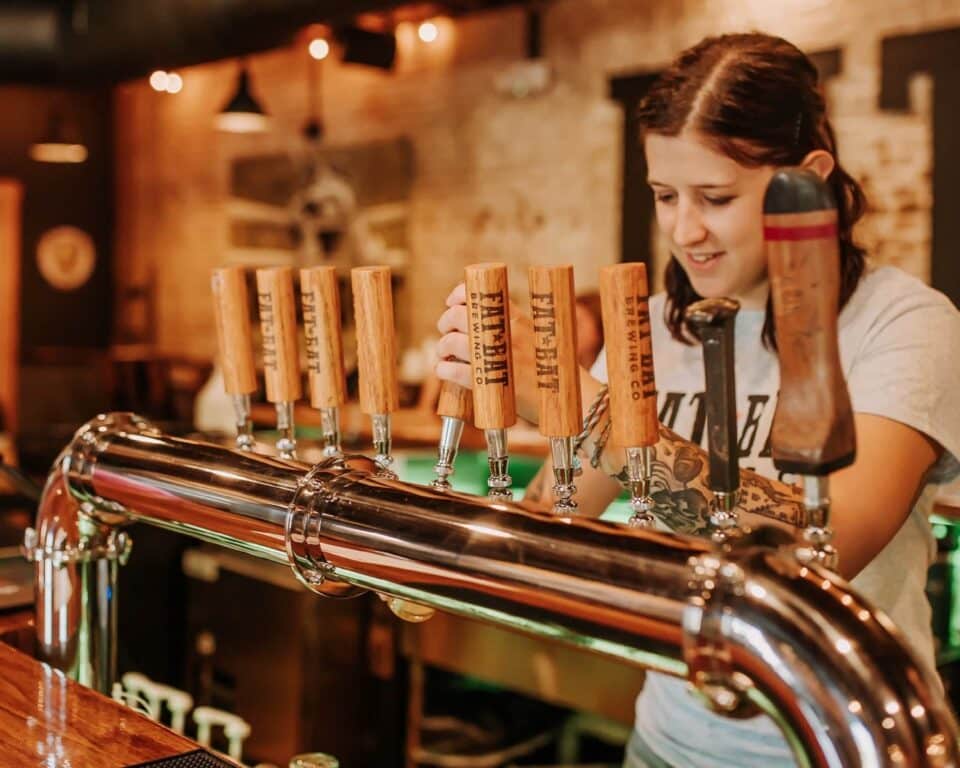Historic Colonial Williamsburg is the key to satisfying your colonial cuisine curiosity. Visitors can not only relive the history of America’s Virginia Colonies but can also enjoy delicious, majestic food found only here. Bonus: the current-times cuisine is just as mouth-watering.
Kate Burnham-Hull, Tavern Program Supervisor of the Colonial Williamsburg Foundation, shed some light on the historical taverns that serve colonial fare to modern-day visitors. “We are a very large and complex organization comprising both the Colonial Williamsburg Foundation and Colonial Williamsburg Company, working in tandem toward the same goals,” she explained.
Tasty Tavern Fare
Four taverns in the Historic Area operate as restaurants: James Shields Tavern, Josiah Chowning’s Tavern, Christiana Campbell’s Tavern and King’s Arms Tavern.
Other taverns in the Historic Area include the Raleigh Tavern (used for program performances), Wetherburn’s Tavern (open for tours to guests with tickets), Market Square Tavern (used for lodging) and Brickhouse Tavern (also used for lodging).
“The Wetherburn Tavern and Market Square Tavern are both original structures. The Shields, Campbell’s, and King’s Arms were reconstructed on their original sites. Chowning’s was reconstructed very near its original site,” said Kate. “The reconstruction of Shields was able to retain some of the original brick in the wine cellar. We know from the excavation that it sits on the same exact footprint as the original at the time of Jean Marot’s death. After our archaeologists excavated each site, architectural plans for the taverns were used to guide the reconstruction of the taverns.”
The taverns and shops within Colonial Williamsburg employ actors to re-create the authentic ambience of Colonial Virginia. Every employee plays a role in the interpretation of Williamsburg’s and the founding nation’s history.
The menus are chosen in collaboration with Executive Chef Linwood Blizzard and the Tavern Chefs, and then finalized through the Director of Food & Beverage of Historic Area, Seth Farrell. They strive to use fresh, local and historically accurate (as much as possible) ingredients. “We utilize fresh herbs from the King’s Arms, Campbell’s and Shields Tavern’s gardens, including rosemary, sage, oregano, basil and lavender.”
Upon arriving at the historic taverns, guests are welcomed warmly and invited to sit down and dine (be sure to make a reservation first!). The atmosphere is one of holiday and family fun. The wooden floors creak as you go up the stairs to the dining rooms. Candles everywhere shed flickering light onto old-fashioned plates, and the garbed servers seemed genuinely happy to see the patrons.
Historic dining creates cuisine that is coastal, game-centered, local and based on a menu from hundreds of years ago. Christiana Campbell‘s Tavern’s wildly popular spoonbread is a delicious before-dinner treat served with their famous sweet potato muffins. The Gloucester Chicken and Seafood Fricassees are popular and well-known entrees. Brunswick Stew and Ale Potted Beef are genuine, and genuinely delicious, eighteenth-century foodstuffs.
King’s Arms Tavern on Duke of Gloucester street serves up Mrs. Vobe’s Peanut Soupe (a delicious, warm, hearty, velvety smooth peanut-cream soup garnished with roasted peanuts—there are dreams about this soup!), Game Pie and Prime Rib, and all taverns serve historically accurate and tastefully creative desserts. The Syllabub, for example, is a frothy wine-laced citrus cream with berries and lemon zest, and don’t miss the brandy-spiced bread pudding in warm vanilla-bean sauce.
This summer, Colonial Williamsburg is serving up a special pig roast, the Thomas Jefferson Wine Dinner, beers in the ‘burg, The Life of the Jolly Pyrate (dinner theatre) and a whole host of other holiday events later in the year, like Mrs. Campbell’s Tea. After dinner (or before), Colonial Williamsburg visitors can stroll through the street to shop, see the Governor’s Palace, watch reenactments and attend a ghost tour (I highly recommend the Official Colonial Williamsburg Ghost Walk).
Libations Old and New
Food was extremely important to the people of Williamsburg, as many traditions were brought from England and elsewhere to re-create in this new land. Alcohol also played a large role in colonial society. Fresh water was plentiful in the new world, but it needed something extra to keep it safe to drink—hence, beer, cider and wine were produced here and added to the daily menu. Of course, this is important to current-day visitors as well.
The Greater Williamsburg area is pushing the boundaries on beers, wine, mead and more. This old land is booming with new places to eat, drink and be merry thanks to fantastic food and great alcohol. The Silver Hand Meadery serves visitors flights of mead, which is made like wine, but from honey. The Meadery also offers artisanal honey tastings for non-drinkers. Down the road, Alewerks Brewing Company—Williamsburg’s hometown brewery—offers guests an ever-changing rotation of beer on draft and for sale. The Virginia Beer Company opened its doors in Williamsburg and features a new craft brewery, taproom and garden all in the confines of an old auto body shop.
If wine is the beverage of choice, the award-winning Williamsburg Winery is a must-visit. Vines have been growing here for more than 350 years, and the winery is one of the first in the state of Virginia to receive a 90-point rating from Robert Parker’s Wine Advocate. The grounds are gorgeous and relaxing, and the tasting room offers flights of wine and nibbles for sale.
Modern-Day Recommendation
Hungry, but don’t want to sit down in one of the taverns? The Jamestown Pie Company has pies of all kinds, plus pizza and BBQ. Heaven! You can’t miss it on Jamestown Road on the way to the Jamestown Settlement; they also deliver to all resorts and hotels within five miles.
There’s so much to eat, drink, see and experience in Colonial Williamsburg—hop in the car for a little road trip this summer, discover your history and take a big bite!
Get more information on Colonial Williamsburg hotels, lodging and attractions on the Colonial Williamsburg website.
- Photography: ©Colonial Williamsburg/David M. Doody












